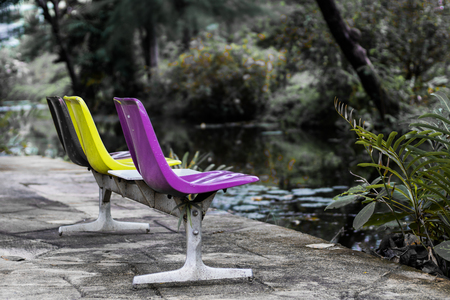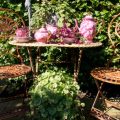Introduction to Feng Shui in the British Garden
Feng Shui, an ancient Chinese art of spatial arrangement, seeks harmony between individuals and their environment by balancing natural elements. While its roots are deeply embedded in Eastern philosophy, the principles of Feng Shui can be thoughtfully woven into the fabric of British gardens, celebrated for their lush greenery and storied tradition. Integrating Feng Shui in a British context requires a sensitive approach—one that honours both the gentle cadence of local landscapes and the time-honoured customs of British outdoor living. By observing balance, flow, and connection to nature, it is possible to create garden spaces where energy moves freely and every element feels purposefully placed. In doing so, we not only respect the authenticity of Feng Shui but also enhance our connection to the tranquil beauty of a classic British garden.
2. Understanding the British Climate: Implications for Outdoor Furniture
The essence of successful garden furniture arrangement in the UK lies in acknowledging the distinctive British climate. Renowned for its unpredictability, Britains weather can shift from radiant sunshine to a sudden downpour, and even the mildest of summers often bring cool breezes and persistent drizzle. These climatic nuances significantly influence the choice of materials, layout strategies, and the durability of your garden furniture—factors that are also crucial in upholding Feng Shui principles.
Material Selection: Weathering the Elements
Choosing the right materials is paramount for achieving both longevity and harmony within your outdoor space. While some materials may exude aesthetic appeal, they may falter under constant exposure to moisture or temperature fluctuations. Consider the following comparison:
| Material | Weather Resistance | Maintenance Level | Feng Shui Suitability |
|---|---|---|---|
| Teak Wood | Excellent – natural oils resist rain and rot | Low to Moderate (occasional oiling) | Very Good – warm, grounding energy |
| Metal (Powder-coated Steel/Aluminium) | Good – rust-resistant coatings available | Low (wipe down when needed) | Good – sleek, modern look supports clarity |
| Rattan (Synthetic/All-weather) | Excellent – designed for outdoor use | Low (easy cleaning) | Very Good – woven patterns enhance flow |
| Plastic/Resin | Varies – some UV and water-resistant options | Low (easy care) | Moderate – less ‘earthy’ feel but practical |
Laying Out Your Space: Navigating Rain and Sunlight
The spatial arrangement should reflect not only Feng Shui’s emphasis on balance and energy flow but also practical shelter from wind and rain. Position seating away from prevailing winds (often south-westerly in Britain) and take advantage of natural or structural shade to protect from unexpected sunbursts. Opt for flexible layouts that allow for movement of furniture as seasons change—foldable chairs or stackable tables can be invaluable assets.
Sustainability & Longevity: A Harmonious Investment
The British climate’s wear-and-tear means investing in high-quality, weatherproof cushions and covers is not just wise, but essential for maintaining harmony over time. Regular cleaning routines and seasonal storage solutions ensure that your garden furniture continues to foster positive chi while withstanding nature’s temperaments.
A thoughtful approach to material choice and spatial planning not only prolongs the life of your outdoor furnishings but also ensures your garden remains an inviting, balanced sanctuary through every season—a testament to both British resilience and the timeless art of Feng Shui.

3. Choosing Garden Furniture: Style, Placement, and Flow
When selecting garden furniture for your British outdoor space, it’s essential to harmonise the timeless charm of English gardens with the principles of Feng Shui. Begin by choosing pieces that evoke a sense of place—think classic wrought iron benches, weathered teak tables, or rattan chairs with soft, muted cushions reminiscent of an English country retreat. Opt for materials resilient to the ever-changing British weather, ensuring both durability and comfort.
Embracing Functional Elegance
Functionality should never compromise style. Select seating and tables that not only complement your garden’s character but also invite relaxation and social connection. In line with Feng Shui, avoid overcrowding; each piece should have breathing room, allowing energy—or chi—to flow freely through your garden.
Placement for Harmony and Accessibility
Consider the natural pathways within your outdoor space. Position furniture along these lines so movement feels effortless and organic. For instance, a small bistro set nestled beneath a blossoming tree encourages quiet reflection, while a larger dining ensemble near the house fosters lively gatherings. Keep walkways clear and unobstructed to maintain good energy flow and easy access in all seasons.
Visual Flow and Spatial Balance
Balance is key in both British design sensibility and Feng Shui practice. Arrange furniture in gentle curves rather than rigid lines to soften the landscape and mirror the undulating forms found in nature. Pair heavier elements, like stone benches or large planters, with lighter pieces to create visual equilibrium. This thoughtful approach ensures your garden remains inviting year-round, blending quintessential British allure with holistic spatial harmony.
4. Positioning for Balance: Practical Feng Shui Arrangements
Arranging garden furniture in harmony with Feng Shui principles, especially within the unique context of British gardens, is all about balance and flow. The aim is to create spaces that not only look inviting but also foster positive energy, support conversation, and suit the UK’s varied climates and garden sizes. Here’s a step-by-step approach to achieve just that:
Step 1: Define the Garden’s Energy Entry Points
Begin by identifying where energy (Qi) naturally enters your garden—commonly via paths, gates, or doors. In Britain, these are often along stone walkways or near patios leading from the home. Avoid blocking these routes with large furniture pieces; instead, keep them clear to allow free movement and vibrant energy flow.
Step 2: Establish Conversation Zones
Create areas that encourage sociability by arranging seating in circular or semi-circular patterns. This layout fosters inclusivity and ease of conversation, essential in British social culture. For smaller gardens or terraces common in UK homes, opt for compact bistro sets or benches placed at gentle angles rather than strict lines.
Step 3: Maintain Open Views
British gardens often feature charming views—be it a cityscape, countryside, or your own flower beds. To retain this connection with nature, avoid placing tall chairs or screens in front of focal points such as ponds or borders. Instead, use low-profile furniture to maintain sightlines and invite tranquillity into the space.
Step 4: Adapt for Weather and Space
| Garden Size | Recommended Arrangement | Weather Consideration |
|---|---|---|
| Small Urban Patio | Bistro set tucked into a sunny corner; foldable chairs for flexibility | Choose weatherproof materials like powder-coated metal or treated wood; position under an awning if possible |
| Medium Suburban Garden | L-shaped seating around a fire pit; modular furniture to adapt to gatherings | Select cushions with quick-dry technology; store away during heavy rain |
| Large Rural Plot | Zoned seating—dining area near the house, lounge at the far end for sunset views | Use natural windbreaks like hedges; opt for heavier furniture to withstand gusts |
Step 5: Encourage Flow Between Spaces
Use pathways and stepping stones to connect different zones, guiding movement gracefully throughout your garden. This not only supports good Qi circulation but also reflects the quintessentially British love of meandering through green spaces.
Quick Tips for Balance and Harmony
- Avoid clutter—keep pathways and social zones unobstructed.
- Incorporate round tables or curved benches to soften angles and promote unity.
- Add a water feature close to seating areas if possible—water invites calm and prosperity according to Feng Shui tradition.
- Balance hard surfaces (like paving) with lush planting to soften the overall look.
Your Balanced Garden Awaits
By thoughtfully positioning your garden furniture with Feng Shui principles tailored to the British climate and landscape, you’ll enjoy a harmonious outdoor space that feels both welcoming and energising—perfect for everything from afternoon tea to lively summer gatherings.
5. Enhancing Energy with Accessories and Greenery
Curating a Harmonious Outdoor Ambience
Accessories and greenery play a pivotal role in fine-tuning the energy flow within your garden. In the British climate, where outdoor spaces often tend towards cosiness and compactness, making thoughtful choices about ornaments, fabrics, and native plants can transform even the smallest patio into a serene retreat. The key is to maintain balance—pairing each piece of furniture with complementary elements that encourage positive Chi while reflecting British sensibilities.
Pairing Furniture with Native Plants
Native plants such as lavender, foxglove, or ferns are not only well-adapted to the British climate but also invite natural harmony into your garden. Place pots of fragrant herbs near seating areas to provide a gentle sensory backdrop, or cluster soft grasses beside benches to soften hard lines and promote tranquility. Remember, Feng Shui encourages the use of rounded shapes and flowing forms, so select planters and containers that echo these qualities for an even gentler atmosphere.
Selecting Ornaments with Intention
Garden ornaments should be chosen mindfully; opt for natural materials like stone or terracotta to ground your space and avoid sharp angles that may disrupt energy flow. Traditional British pieces such as birdbaths or sundials can double as focal points while supporting Chi circulation. For smaller spaces, hang wind chimes or position mirrored ornaments strategically to reflect light and expand visual boundaries without overwhelming the area.
Using Fabrics to Soften and Connect
Cushions and throws in weather-resistant textiles can introduce both comfort and colour. In line with Feng Shui principles, choose calming hues—sage green, gentle blues, or earthy neutrals—that connect your seating area to its natural surroundings. Soft furnishings also allow you to update your garden’s look seasonally, staying attuned to Britain’s shifting weather while consistently nurturing a sense of peace.
Tip: Layer Light for Evening Serenity
Enhance evening energy by incorporating lanterns or solar-powered fairy lights among greenery and around seating zones. This soft illumination fosters warmth and encourages lingering outdoors, further amplifying positive Chi long after sunset.
6. Addressing Common Challenges: Wind, Rain, and Compact Spaces
In the British climate, garden design faces unique hurdles: persistent rain, gusty winds, and often limited outdoor space. Harmonising these challenges with Feng Shui principles requires both creativity and practicality. To ensure your garden remains a welcoming retreat throughout the seasons, focus on adaptable solutions that support both energetic flow and everyday comfort.
Weatherproofing with Style
Opt for robust, water-resistant materials such as treated hardwoods or powder-coated metals to withstand rain and dampness. Cushions with quick-dry, mould-resistant fabrics not only endure British showers but also maintain the softness and warmth encouraged by Feng Shui’s earth element. Store soft furnishings in waterproof chests or under sheltered areas when not in use to keep chi flowing freely and spaces clutter-free.
Taming the Wind
Wind can disrupt both energy balance and comfort. Position heavier furniture—benches or solid tables—towards the prevailing wind direction to anchor the space. Use living screens like bamboo, evergreen shrubs, or trellises with climbing plants to act as natural windbreaks, softening harsh gusts while inviting gentle breezes that refresh stagnant chi. Avoid placing lightweight items in exposed zones; instead, cluster them near walls or fences for added stability.
Maximising Small Spaces
British gardens are often compact, making efficient layout essential. Choose modular or foldable furniture that can be easily rearranged to accommodate gatherings or create open space when needed. Circular arrangements encourage inclusive conversation and optimal energy circulation even in tight corners. Reflective surfaces—like mirrors or glazed pots—can visually expand boundaries while supporting water element balance.
Welcoming All Seasons
To keep your garden inviting year-round, introduce covered pergolas or retractable awnings that provide shelter without obstructing light or movement. Layered lighting—solar lanterns, fairy lights strung through trees—brings warmth and vitality during gloomy evenings, echoing the harmonious interplay of fire and earth elements in Feng Shui. By blending resilient materials, flexible layouts, and sensory touches suited to Britain’s weather, you create an outdoor haven where positive energy thrives whatever the forecast.
7. Conclusion: Harmonising East and West in Your British Garden
Drawing together best practices for creating outdoor spaces where the spirit of Feng Shui meets British lifestyle elegance is a rewarding journey that goes beyond mere aesthetics. By thoughtfully arranging your garden furniture to respect the principles of balance, flow, and energy, you invite harmony and comfort into your daily life—even under the capricious British skies. Embracing Feng Shui’s elemental wisdom, while honouring Britain’s unique climate and cultural nuances, ensures your garden becomes a sanctuary that feels both distinctly local and subtly exotic.
Consider how water features can mirror the gentle rains of an English summer, or how wooden benches nestled among fragrant herbaceous borders evoke a sense of grounded tranquillity. Allow pathways to meander softly, drawing visitors through spaces that feel intentional and welcoming. Above all, let your garden reflect your own personality—combining the structured orderliness beloved by British gardeners with Feng Shui’s invitation to open up to nature’s vitality.
Ultimately, a well-balanced garden is more than the sum of its parts; it is a living composition where East meets West. By marrying these philosophies, you create an outdoor retreat that supports wellbeing, encourages sociability, and quietly celebrates the beauty of both traditions. Your British garden, arranged in accordance with Feng Shui principles, becomes not just a place to sit but a space to truly belong.


